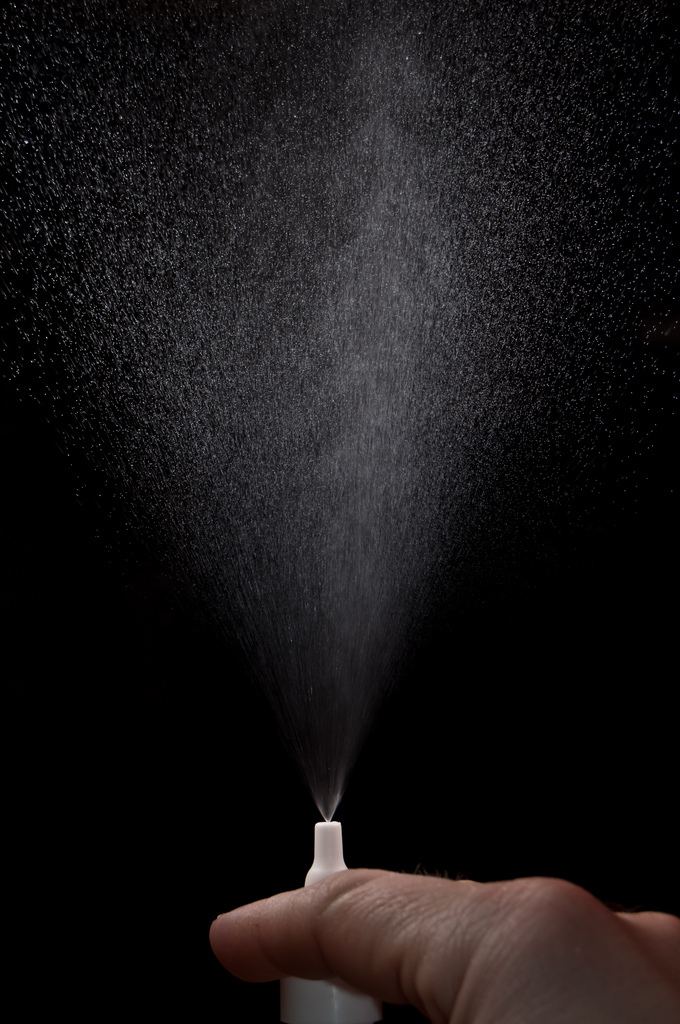 | ||
Nasal sprays are used as local treatments for conditions such as nasal congestion and allergic rhinitis. In some situations, nasal delivery route is preferred because it provides an agreeable alternative to injection or pills. Substances can be assimilated extremely quickly and directly through the nose. Many pharmaceutical drugs exist as nasal sprays for systemic administration (e.g. treatments for pain, migraine, osteoporosis and nausea). Other applications include hormone replacement therapy, treatment of Alzheimer's disease and Parkinson's disease. Nasal sprays are seen as a more efficient way of transporting drugs with potential use in crossing the blood–brain barrier.
Contents
Antihistamine sprays
Antihistamines work by competing for receptor sites to block the function of histamine, thereby reducing the inflammatory effect. Antihistamine nasal sprays include:
Corticosteroid sprays
Corticosteroid nasal sprays can be used to relieve the symptoms of sinusitis, hay fever, allergic rhinitis and non-allergic (perennial) rhinitis. They can reduce inflammation and histamine production in the nasal passages, and have been shown to relieve nasal congestion, runny nose, itchy nose and sneezing. Side effects may include headaches, nausea and nose bleeds. Corticosteroid nasal sprays include:
Immunization sprays
Influenza vaccine is available in the form of a nasal spray like Live attenuated influenza vaccine (LAIV).
Nonsteroidal anti-inflammatory sprays
Ketorolac tromethamin is the first and only NSAID nasal spray which is an effective non-narcotic alternative for patients who require pain relief at the opioid level.
Saline sprays
Saline sprays are typically non medicated. A mist of saline solution containing sodium chloride is delivered to help moisturize dry or irritated nostrils. This is a form of nasal irrigation. They can also relieve nasal congestion and remove airborne irritants such as pollen and dust thereby providing sinus allergy relief.
Three types of nasal sprays preparations of sodium chloride are available including hypertonic (3% sodium chloride or sea water), isotonic (0.9% sodium chloride) and hypotonic (0.65% sodium chloride). Isotonic solutions have the same salt concentration as the human body, whereas hypertonic solutions have a higher salt content and hypotonic solutions have a lower salt content. Isotonic saline nasal sprays are commonly used in infants and children to wash out the thick mucus from the nose in case of allergic rhinitis. Hypertonic solutions may be more useful at drawing moisture from the mucous membrane and relieving nasal congestion.
Natural nasal sprays that include chemical complexes derived from plant sources such as ginger, capsaicin and tea-tree oil are also available. There is however, no trial-verified evidence that they have a measurable effect on symptoms.
Topical decongestant sprays
Decongestant nasal sprays are available over-the-counter in many countries, including: the United States, New Zealand, Ireland and the UK, work to very quickly open up nasal passages by constricting blood vessels in the lining of the nose. Prolonged use of these types of sprays can damage the delicate mucous membranes in the nose. This causes increased inflammation, an effect known as rhinitis medicamentosa or the rebound effect. As a result, decongestant nasal sprays are advised for short-term use only, preferably 5 to 7 days at maximum. Some doctors advise to use them 3 days at maximum. A recent clinical trial has shown that a corticosteroid nasal spray, may be useful in reversing this condition. Topical nasal decongestants include:
Combination sprays
Combination use of two medications as nasal spray preparation has been frequently prescribed by doctors.
List of combination nasal sprays:
